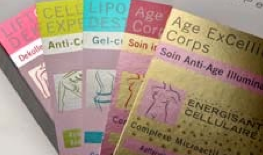 What you need to know about the cold-foil transfer process
What you need to know about the cold-foil transfer process
It's Saturday evening and a young woman is eagerly looking forward to going out. She sits in front of the mirror and applies her makeup and a hint of perfume which she deliberately chose for its particular fragrance. But it was the packaging that caught her eye because it was somehow more attractive than usual. It sparkled, had delicate color shades and shiny metallic hues. Cold foil leaves nobody cold.
For customers they are beautiful, elegant, noble – simply attractive. For a printing company they represent additional value adding potential: high-grade cold foil applications for Value Added Printing. Packaging, labels, commercial printing jobs – all can be further enhanced through inline overprinting of the metallic images in the printing units downstream of the unit where the foil is applied. These images are only separated from the carrier foil and transferred to the paper in the areas where adhesive ink has been applied. Additional costs for expensive embossing forms, as with the hot-foil process, are eliminated, as are additional outside production steps. The cold foil can be handled inline, thus minimizing the steps in the process chain, which means the order can be delivered sooner. In comparison to hot-foil stamping, the cold-foil application enables ultra-fine lines and elements to be reproduced and realized. A characteristic that has proved its worth in packaging printing when it comes to integrating security elements. The printing units can be used as normal printing units if foil applications are not involved. Changeover requires only a few manual operations. The ROLAND InlineFoiler Prindor is available for the ROLAND 500 as an upgrade, and can likewise be retrofitted for the ROLAND 700 HiPrint series as from 2004.
What sort of quality does the cold-foil transfer process provide?
The ROLAND InlineFoiler Prindor can reproduce full solids, the finest details and line elements as well as halftone areas. Compared with hot-foil stamping, full solids are somewhat less brilliant because there is no heat influence. Halftone areas with screen rulings up to 60 lines per centimeter (150 dpi) can be reproduced in high quality and, depending on the foil and substrate used, area coverages from 20 to 80 percent can be reproduced in outstanding quality. The same applies to fine lines (0.25 pt), letters (4 pt) and details, which can be reproduced with perfect edge definition. Subsequent embossing of the foil-enhanced sheets in a second pass is possible.
What consumables are needed?
What components are used for cold-foil enhancement jobs, and how do these differ from the consumables used for conventional printing? Under the system brand of printcom, manroland offers a start-up set of process-compliant system components for technically flawless commissioning of the ROLAND InlineFoiler Prindor. The user is of course also free to work with consumable materials from other vendors.
Cold foil
Cold foils are available in different color tones and surface properties (glossy, matt) and also with holographic effects but the basic structure of all of them is the same. The respective color impression comes from colorization of the protective coating layer. The composition of the separating layer (silicone) determines the separating behavior of the foil as well as its overprintability with the respective ink system (conventional/UV). Some types of foil have a so-called adhesive layer, which facilitates the connection to the adhesive ink and has an influence on drying.
Inks and coatings
Overprinting the foil image areas with 4C process inks can result in an impressive color space. For this, most jobs can only be produced with one type of foil (silver). Conventional applications are possible on coated or uncoated paper, board, absorbent or structured substrates. Conventional applications on coated substrates can be overprinted using UV. Protective coating is particularly recommended when overprinting with high ink coverage.
Blanket
For cold-foil enhancement a specific application blanket is used instead of a conventional one. Besides distortion-free foil guidance in the application nip gap, the blanket scores in terms of optimum transfer of the metalized solids, screens and details, thanks to special surface properties.
Cold-foil adhesive
The adhesive ink for cold-foil transfer with sheetfed presses is an oil-based ink with a reduced number of pigments and higher tack. This higher tack is elementarily important for a complete and perfect separation of the foil layer from the carrier material. Quality variations during production are minimized by continuous regulation of the adhesive ink feed. Ink density can be densitometrically recorded and regulated during production.


















































































